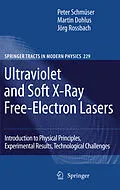In the introduction accelerator-based light sources are considered and a comparison is made between free-electron lasers and conventional quantum lasers. The motion and radiation of relativistic electrons in undulator magnets is discussed. The principle of a low-gain free-electron laser is explained and the pendulum equations are introduced that characterize the electron dynamics in the field of a light wave. The differential equations of the high-gain FEL are derived from the Maxwell equations of electrodynamics. Analytical and numerical solutions of the FEL equations are presented and important FEL parameters are defined, such as gain length, FEL bandwidth and saturation power. A detailed numerical study of the all-important microbunching process is presented. The mechanism of Self Amplified Spontaneous Emission is described theoretically and illustrated with numerous experimental results. Three-dimensional effects such as betatron oscillations and optical diffraction are addressed and their impact on the FEL performance is analyzed. The world's first soft X-ray FEL, the user facility FLASH at DESY, is described in some detail in order to give an impression of the complexity of such an accelerator-based light source. Finally, the physical and technological challenges of X-ray FELs are addressed while some of the more involved calculations are put into the appendices, where also supplementary material can be found.
Klappentext
The high scienti?c interest in coherent X-ray light sources has stimulated world-wide e?orts in developing X-ray lasers. In this book a particularly promising approach is described, the free-electron laser (FEL), which is p- sued worldwide and holds the promise to deliver ultra-bright X-ray pulses of femtosecond duration. Other types of X-ray lasers are not discussed nor do we try a comparison of the relative virtues and drawbacks of di?erent concepts. The book has an introductory character and is written in the style of a universitytextbookforthemanynewcomerstothe?eldoffree-electronlasers, graduate students as well as accelerator physicists, engineers and technicians; it is not intended to be a scienti?c monograph for the experts in the ?eld. Building on lectures by one of us (J. R.) at the CERN Accelerator School, and motivated by the positive response to a series of seminars on "FEL t- ory for pedestrians", given by P. S. within the framework of the Academic Training Program at DESY, we have aimed at presenting the theory of the low-gainandthehigh-gainFELinaclearandconcisemathematicallanguage. Particular emphasis is put on explaining and justifying the assumptions and approximations that are needed to obtain the di?erential equations descr- ing the FEL dynamics. Although we have tried our best to be "simple", the mathematical derivations are certainly not always as simple as one would like them to be. However, we are not aware of any easier approach to the FEL theory. Some of the more involved calculations are put into the appendices.
Inhalt
Undulator Radiation.- Low-Gain FEL Theory.- One-Dimensional Theory of the High-Gain FEL.- Discussion of the High-Gain FEL Equations.- Refinements of the One-Dimensional FEL Theory.- Self Amplified Spontaneous Emission.- The Ultraviolet and Soft X-Ray FEL in Hamburg.- Physical and Technological Challenges of an X-Ray FEL.
